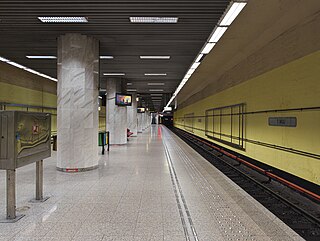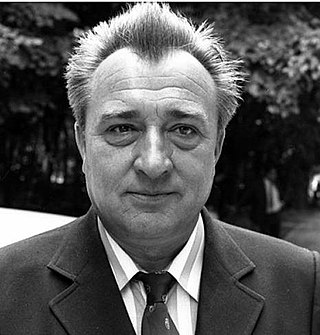
Bucharest is the capital and largest city of Romania. The metropolis stands on the River Dâmbovița in south-eastern Romania. Its population is officially estimated at 1.76 million residents within a greater metropolitan area of 2.3 million residents, which makes Bucharest the 8th most-populous city in the European Union. The city area measures 240 km2 (93 sq mi) and comprises 6 districts (Sectoare), while the metropolitan area covers 1,811 km2 (699 sq mi). Bucharest is a beta global city, a major cultural, political and economic hub, and the country's seat of government.

The Bucharest Metro is an underground rapid transit system that serves Bucharest, the capital of Romania. It first opened for service on 16 November 1979. The network is run by Metrorex. One of two parts of the larger Bucharest public transport network, Metrorex has an average of approximately 720,000 passenger trips per weekday, compared to the 1,180,000 daily riders on Bucharest's STB transit system. In total, the Metrorex system is 80.1 kilometres (49.8 mi) long and has 64 stations.

Fotbal Club Rapid 1923, commonly known as Rapid București (Romanian pronunciation:[raˈpidbukuˈreʃtʲ]; or simply as Rapid, is a Romanian professional football club based in Bucharest, that competes in the Liga I. It was founded in 1923 by employees of the Grivița workshops as the Asociația Culturală și Sportivă CFR.

1 Mai(1st of May in Romanian) is a metro station in northern Bucharest, serving line M4. It is situated in Chibrit or Clăbucet Square, at the intersection of Calea Griviței, Ion Mihalache Boulevard, and Bucureștii Noi Road.It will be serving the M6 line to the airport at Otopeni.

Romania's administration is relatively centralized and administrative subdivisions are therefore fairly simplified.

Militari is a district in the western part of Bucharest, in Sector 6. It is home to more than 100,000 inhabitants.

Sector 1 is an administrative unit of Bucharest located in the northern part of the city. It contains also the northwestern districts of Băneasa and Pipera. Sector 1 is thought to be the wealthiest sector in Bucharest. Like each of Bucharest sectors, there is a Local Court, which it submits to the Bucharest Tribunal.

Valentin Stănescu was a Romanian football goalkeeper and manager.

Podul Grant is a bridge that serves both motorway and lightrail transportation in Bucharest, Romania. It is named after Effingham Grant, the British consul in Bucharest during the mid-19th century. Initially, the bridge was made of steel, and opened in 1910. Between 1979 and 1982, the old bridge was mostly demolished, to make way for a brand new concrete one, with slip ramps and wider lanes. Since then, a number of maintenance and modernisation projects have been executed.

Chiajna is a commune in the south-west of Ilfov County, Muntenia, Romania, immediately west of the capital, Bucharest. It is composed of three villages: Chiajna, Dudu, and Roșu.

The Romanian Radio Broadcasting Company, informally referred to as Radio Romania, is the public radio broadcaster in Romania. It operates FM and AM, and internet national and local radio channels. The local stations are branded under the Radio România Regional umbrella.
Marin Preda Park, formerly known as Giulești Park, is a park in the north-west of Bucharest, Romania. It is named for the Romanian novelist, post-war writer and publisher Marin Preda. Opened in 2017, the park is located in Sector 6 of the city and covers an area of 40 hectares.
Ionuț Alexandru Dobroiu is a Romanian former professional footballer who played as a forward.

Calea Moșilor is both a historic street and a major road in Bucharest, Romania. It runs from the back of the Cocor Shopping Mall, in Sector 3 to Obor, in Sector 2.

Nicușor Dan is a Romanian activist, mathematician, former member of the Chamber of Deputies of Romania as well as founder and former leader of the Romanian political party Save Romania Union (USR). He is currently serving as the Mayor of Bucharest following his successful re-election campaign in the 2024 Romanian local elections as an independent politician.

Cristian Victor Popescu Piedone is a Romanian businessman and politician who served as mayor of Bucharest's Sector 4 from 2008 until 4 November 2015, when he resigned following the Colectiv nightclub fire and the subsequent 2015 Romanian protests. He is currently serving as the mayor of Sector 5 since 2020.
Emil Dumitriu, commonly known as Nichi Dumitru or Dumitriu II, is a Romanian former footballer who played as a forward.

The Social Liberal Humanist Party, formerly Humanist Power Party (Social-Liberal) is a centrist political party in Romania. It was founded in 2015 by members of the Conservative Party (PC) who did not want to merge with the Liberal Reformist Party (PLR), led by Călin Popescu-Tăriceanu.
The history of FC Rapid București covers the time between the foundation of Rapid București, a Romanian football club based in Bucharest, up to the present day.

















